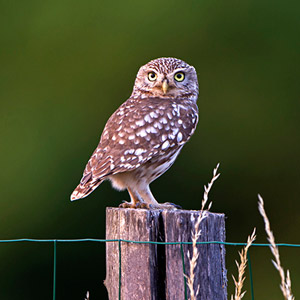Pratique | Conseils
La repasse et les oiseaux : utilisation, avantages, risques et conseils

La repasse est utilisée au printemps pour recenser les Chevêches d’Athéna (Athene noctua).
Photographie : Jean-Paul Leau
Introduction
Dès la préhistoire, les hommes ont éprouvé le besoin d’imiter les cris des animaux, et en particulier des oiseaux, pour les attirer dans leurs pièges. Le simple plaisir de communiquer avec des oiseaux pour les écouter ou pour les voir de plus près est apparu progressivement. La repasse est une technique consistant à diffuser des enregistrements des sons produits par un oiseau afin d’obtenir une réaction (vocale, comportementale) de sa part. Elle est fréquemment utilisée dans le cadre d’études ornithologiques (recensement, modes de communication…), mais aussi parfois simplement pour observer plus vite une espèce rare et/ou discrète. La multiplication des appareils numériques diffusant des sons (lecteurs de fichiers MP3 et de CDs, smartphones, tablettes…) et les amplifiant (enceintes et paraboles portables) l’a démocratisée. Mais si cette technique est pratiquée sans précaution, elle peut occasionner des dérangements et elle est donc très critiquée par certains ornithologues. Dans cet article, nous présentons des exemples d’utilisation de la repasse pour étudier les oiseaux, nous énumérons ses avantages et ses inconvénients, et nous proposons une série de conseils pour limiter les risques de perturbations.
Abstract
Since prehistoric times, humans have felt the need to imitate the calls and songs of animals, especially birds, to attract them into their traps, simply using their mouth and/or their hands or natural decoys. The simple pleasure of communicating with birds to listen them or to see them up closer appeared gradually. The playback or tape-luring is a technique which consists in playing recordings of calls and/or the song of a bird to get a vocal or behavioral reaction from him. It is frequently used for ornithological studies (census, methods of communication …), but sometimes simply to watch quicker a rare and/or shy bird species. The multiplication of digital sounds players (MP3 and CDs players, smartphones…) and amplifiers (speakers and parabolic loudspeakers) has democratized it. But if this technique is used without caution, it can cause disturbances and is therefore highly criticized by some birders. In this article, we present some examples of studies based on tape-luring, we list the advantages and disadvantages of playback, and we propose some tips to reduce the risk of disturbing birds.
Poursuivez la lecture de cet article, en vous abonnant dès maintenant !
Découvrez les Archives d’Ornithomedia.com
Pour seulement 10,00 €TTC/an (ou 6,00 € les 6 mois)
Profitez de plusieurs centaines d’articles en accès illimité et sans aucun engagement.
Compléments
À lire aussi sur Ornithomedia.com
- Applications pour smartphones pour l’identification des oiseaux
- Le houspillage (ou « mobbing ») chez les oiseaux
- Pratiquer le pishing : oui, mais…
- Deux possibles modèles alternatifs à la mini-enceinte RadioShack ?
- Code de bonne conduite pour photographes et observateurs
- Quelques effets de la lune sur l’activité des oiseaux
- Les Grands-ducs d’Europe chantent davantage lors des nuits de pleine lune
- Pourquoi certains oiseaux crient-ils et/ou chantent-ils la nuit ?
Sources
- David Sibley (2011). The Proper Use of Playback in Birding. Sibley Guide. www.sibleyguides.com/2011/04/the-proper-use-of-playback-in-birding/
- Lucie Dutour (2013). Suivis 2012 et 2013 du Pic mar en forêt de Compiègne. Picardie Nature. www.picardie-nature.org
- Birds of India. Bird Call Playback. www.kolkatabirds.com/callplayback.htm#sthash.gKrn5yOa.dpuf
- Laval Roy (2011). On repasse ou on ne repasse pas ??? Des oiseaux sur ma route.
. http://desoiseauxsurmaroute.blogspot.fr/2011/04/on-repasse-ou-on-repasse-pas.html - Paul Beier, Erik C Rogan, Michael F Ingraldi et Steven S Rosenstock (2008). Does forest structure affect reproduction of northern goshawks in ponderosa pine forests? Journal of Applied Ecology. Volume 45, numéro 1, pages : 342–350.
- J. Berton C. Harris, David G. Haskell (2013). Simulated Birdwatchers’ Playback Affects the Behavior of Two Tropical Birds. PLOS ONE. http://journals.plos.org/plosone/article?id=10.1371/journal.pone.0077902
- Mark Constantine. Playback and be damned. The Sound Approach to Birding: A Guide to Understanding Bird Sound. Pages 165-167. https://books.google.fr
- Bradley C. Fedy , Bridget J. M. Stutchbury (2005). Territory defence in tropical birds: are females as aggressive as males? Behavioral Ecology and Sociobiology. Volume 58, numéro 4, pages : 414-422. http://rd.springer.com/article/10.1007/s00265-005-0928-4
- Michael R. Conover (1994). How birds interpret distress calls:implications for applied use of distress call playbacks. Proceedings of the Sixteenth Vertebrate Pest Conference (1994). University of Nebraska. http://digitalcommons.unl.edu/vpc16/12/
- Birdwatch (2013). Tape-luring depletes birds’ energy. Date : 19/10. www.birdwatch.co.uk/channel/newsitem.asp?cate=__14854
- Janne M. Fair, Ellen Paul, Jason Jones, Anne Barrett Clark, Clara Davie et Gary Kaiser (2010). Guidelines to the use of wild birds in research. The ornithological Concil. http://sccp.ca
- Robert D. Magrath, Benjamin J. Pitcher et Janet L. Gardner (2007). A mutual understanding?
- Interspecific responses by birds to each other’s aerial alarm calls. Behavioral Ecology. Volume 18, numéro 5. Pages : 944-951. http://beheco.oxfordjournals.org/content/18/5/944.short
- William J. Sutherland, Ian Newton, Rhys Green. Bird Ecology and Conservation: A Handbook of Techniques. https://books.google.fr
- N. Geberzahn, H. Hultsch (2003). Long–time storage of song types in birds: evidence from interactive playbacks. Proceedings of the Royal Society B. Volume 270, numéro 1519. http://rspb.royalsocietypublishing.org/content/270/1519/1085.short
- John S. Gunn, André Desrochers, Marc-André Villard, Julie Bourque et Jacques Ibarzabal (2000). Playbacks of mobbing calls of Black-capped Chickadees as a method to estimate reproductive activity of forest birds. Journal of Field Ornithology. Volume 71, numéro 3. Pages 472-483. www.bioone.org/doi/abs/10.1648/0273-8570-71.3.472




 1 commentaire
1 commentaire
1 commentaire(s) sur ce sujet
Participer à la discussion !Jean Gabriel BOSELLI
SULIGNAT
Posté le 06 février 2016
Méthode intéressante les limites en sont bien décrite. Ce système permettrait t il d,attirer les mâles avant gardes de l’arrivée des femelles hirondelles. J,ai 2 nids à hirondelles qui sont restés vides en 2014 et 2015. Sinon très bon article, mettant en avant avantages et inconvénients de la methode